5.3.3: Current and Future Climate Change Impacts
- Page ID
- 98746
Unit 5.3.3 - Current and Future Climate Change Impacts
- Please read and watch the following Learning Resources
- Reading the material for understanding, and taking notes during videos, will take approximately 1 hour.
- Optional Activities are embedded.
- Bolded terms are located at the end of the unit in the Glossary. There is also a Unit Summary at the end of the Unit.
- To navigate to Unit 5.3.4, use the Contents menu at the top of the page OR the right arrow on the side of the page.
- If on a mobile device, use the Contents menu at the top of the page OR the links at the bottom of the page.
- Identify current global climate impacts and their confidence level
- Explain several projected abiotic climate impacts and their effects on living organisms
Introduction
Climate change has the potential to render Earth unrecognizable from what any human has ever experienced. These changes will have an immense impact on ecosystem services, global economies, and our own quality of life. Yet, while there is much talk about these risks, there is still too little action addressing its main causes.
Current Climate Change Impacts
Some of the lack of action may be attributed to “climate change” and “future” often being used in the same sentence, giving politicians and industries a false impression that we can deal with climate change once we achieved sufficient economic growth. The reality could however not be further from the truth, as we already see signs of the changes to come here today (Table \(\PageIndex{1}\)), including near-annual crop failures, record-high temperatures, and record-strength coastal storms.
|
Impact |
Evidence |
|---|---|
|
Increased extreme weather |
The rise in weather and climate extremes has led to some irreversible impacts as natural and human systems are pushed beyond their ability to adapt. (high confidence). Widespread, pervasive impacts to ecosystems, people, settlements, and infrastructure have resulted from observed increases in the frequency and intensity of climate and weather extremes, including hot extremes on land and in the ocean, heavy precipitation events, drought, and fire weather (high confidence). |
|
Widespread flood and droughts |
Flood and drought-related acute food insecurity and malnutrition have increased in Africa (high confidence) and Central and South America (high confidence). |
|
Rising sea levels |
Continued and accelerating sea level rise will encroach on coastal settlements and infrastructure (high confidence) and commit low-lying coastal ecosystems to submergence and loss (medium confidence). |
|
Earlier spring activity |
Widespread deterioration of ecosystem structure and function, resilience, and natural adaptive capacity, as well as shifts in seasonal timing have occurred due to climate change (high confidence), with adverse socioeconomic consequences (high confidence). |
| Disease spread | The occurrence of climate-related food-borne and water-borne diseases has increased (very high confidence). The incidence of vector-borne diseases has increased from range expansion and/or increased reproduction of disease vectors (high confidence). Animal and human diseases, including zoonoses, are emerging in new areas (high confidence). |
|
Shifts in species ranges |
Approximately half of the species assessed globally have shifted polewards and to higher elevations on land (very high confidence). |
|
Wildlife population declines |
Climate change has caused substantial damages, and increasingly irreversible losses, in terrestrial, freshwater and coastal and open ocean marine ecosystems (high confidence). The extent and magnitude of climate change impacts are larger than estimated in previous assessments (high confidence). Hundreds of local losses of species have been driven by increases in the magnitude of heat extremes (high confidence), as well as mass mortality events on land and in the ocean (very high confidence) and loss of kelp forests (high confidence). Some losses are already irreversible, such as the first species extinctions driven by climate change (medium confidence). |
Risk: provides a framework for understanding the increasingly severe, interconnected, and often irreversible impacts of climate change on ecosystems, biodiversity, and human systems; differing impacts across regions, sectors, and communities; and how to best reduce adverse consequences for current and future generations.
Adaptation: in human systems, the process of adjustment to actual or expected climate and its effects in order to moderate harm or take advantage of beneficial opportunities. In natural systems, adaptation is the process of adjustment to actual climate and its effects; human intervention may facilitate this.
Resilience: the capacity of social, economic, and ecosystems to cope with a hazardous event, trend, or disturbance, responding, or reorganizing in ways that maintain their essential function, identity, and structure as well as biodiversity in case of ecosystems while also maintaining the capacity for adaptation, learning, and transformation.
Mitigation: reducing emissions, and stabilizing the levels, of heat-trapping greenhouse gases in the atmosphere.
Confidence: each finding is grounded in an evaluation of underlying evidence and agreement. A level of confidence is expressed using five qualifiers: very low, low, medium, high and very high.
Between June 25 and July 1, 2021, British Columbia experienced a massive heat dome with temperatures reaching 49.6oC in some areas. Scientists have stated that climate change was a contributing factor. More than 500 deaths were attributed to the heat. Glaciers throughout British Columbia are in retreat, with losses ranging from 6% to 34% from 1985-2005, and their melting is increasing. See more from the British Columbia Provincial Government: Change in Size of B.C. Glaciers.
A summary of the impacts of climate change on natural disasters is given in Figure \(\PageIndex{1}\). The major types of disasters related to climate are floods and storms, but the health implications of extreme temperatures are also becoming a great concern. In the decade 1971 to 1980, extreme temperatures were the fifth most common natural disasters; by 2001 to 2010, they were the third most common.
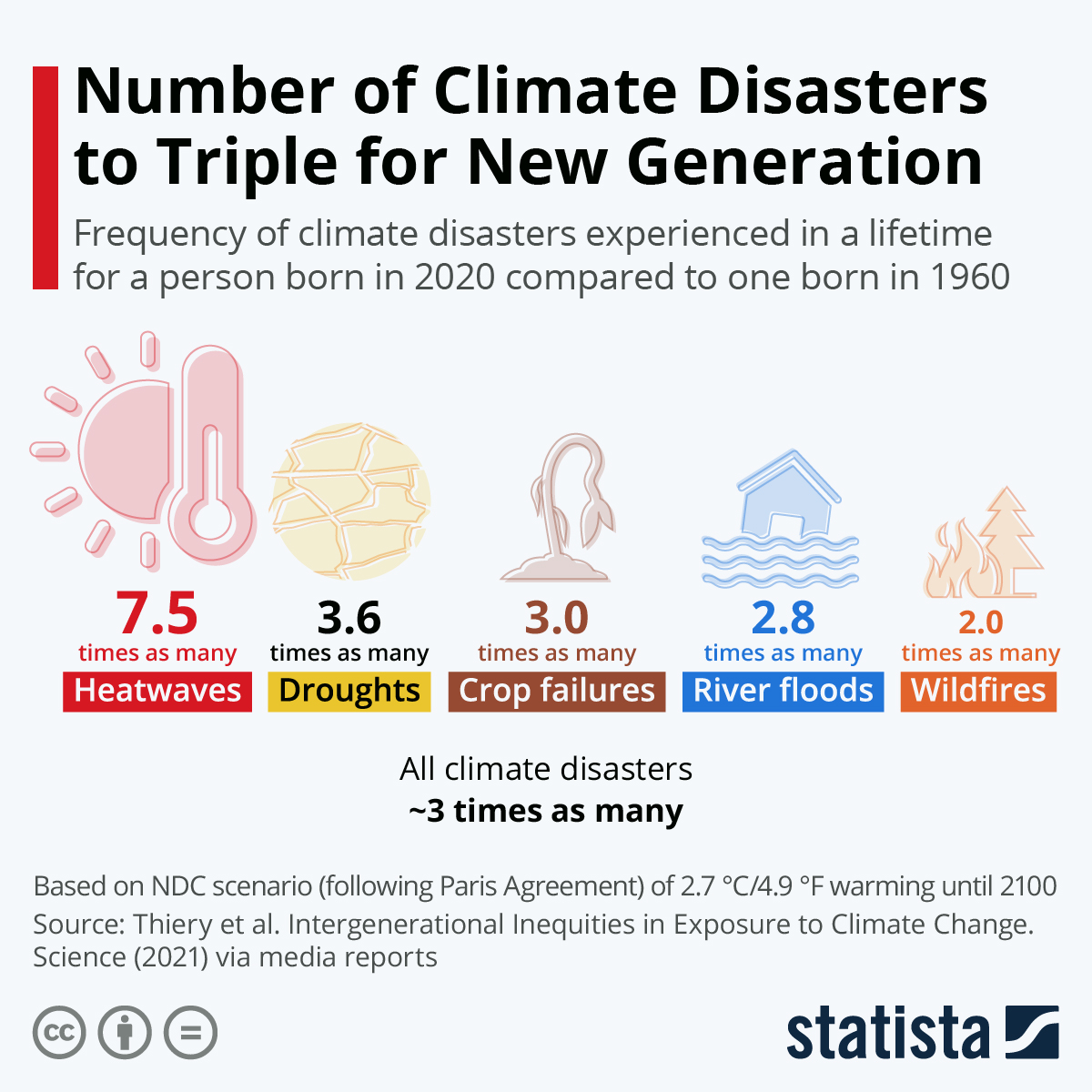
"The mountain pine beetle (Dendroctonus ponderosae Hopkins) is native to western North America, from northern Mexico to northern British Columbia. It is also present in an isolated population of pine that is surrounded by prairie in the Cypress Hills area of southwestern Saskatchewan, which was likely infested in the early 1980s. In the 2000s, the beetle significantly expanded its range in Canada, invading new habitat east of the Rocky Mountains in northeastern British Columbia and northern Alberta (Figure \(\PageIndex{2}\) left)."1
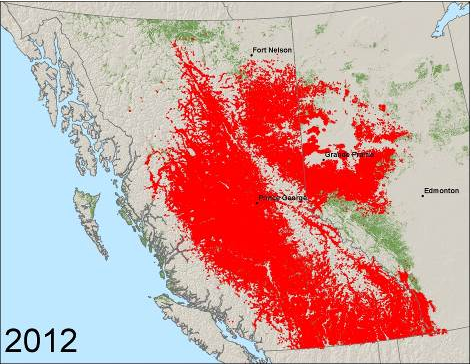
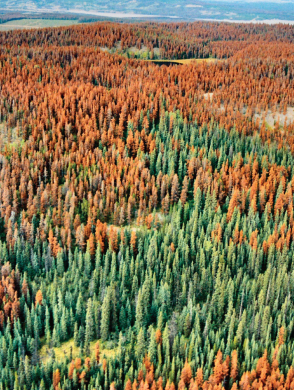
"Most species of pine that grow in the beetle’s range are readily attacked, with the exception of Jeffrey pine. In Canada, these hosts include ponderosa, western white, whitebark, limber pines, and, very recently, jack pine in the expanded range. Lodgepole pine is the most common host in the mountain pine beetle’s range in British Columbia."1
"This small beetle attacks and kills mature trees by boring through the bark and mining the phloem (living tissue in vascular plants that carries organic nutrients). Its eggs hatch into larvae that consume the phloem, killing the tree. The beetles are killed by very cold winter weather, which historically has kept their numbers in check."2
"Trees will attempt to repel the beetles by releasing quantities of resin, which mixes with the boring dust and forms a soft, white or reddish pitch tube around each borehole. These pitch tubes usually appear from the duff line to a top diameter of 15cm. Infected trees' foliage turns yellow and then red by the spring of the year following the initial beetle attack. Most of the needles drop from the tree after two years, leaving a dead grey snag."2
"In British Columbia, the northern limit of the beetle’s range has been limited by cold winter temperatures (−40°C) and cool summers. Outbreaks have been linked to favorable weather in both summer and winter. Warm, dry summers are good for beetle development and dispersal, and drought stress reduces tree defenses. In the late 1990s, after several relatively warm winters, a massive outbreak resulted in the loss of millions of hectares of pine forest in British Columbia over the next 15 years."1,2
Resources:
1. Government of Canada. 2021. Mountain pine beetle (factsheet). Natural Resources Canada [Online]. Available from: https://www.nrcan.gc.ca/forests/fire-insects-disturbances/top-insects/13397
2. Government of British Columbia. 2022. Mountain pine beetle. Forest Health [Online]. Available from: https://www2.gov.bc.ca/gov/content/industry/forestry/managing-our-forest-resources/forest-health/forest-pests/bark-beetles/mountain-pine-beetle
Future Climate Change
Many greenhouse gases stay in the atmosphere for long periods of time. As a result, even if emissions stopped increasing, atmospheric greenhouse gas concentrations would continue to remain elevated for hundreds of years. Moreover, if we stabilized concentrations and the composition of today’s atmosphere remained steady (which would require a dramatic reduction in current greenhouse gas emissions), surface air temperatures would continue to warm (Figure \(\PageIndex{3}\)). This is because the oceans, which store heat, take many decades to fully respond to higher greenhouse gas concentrations. The ocean’s response to higher greenhouse gas concentrations and higher temperatures will continue to impact climate over the next several decades to hundreds of years. Thus, past and present GHG emissions will affect climate far into the future.
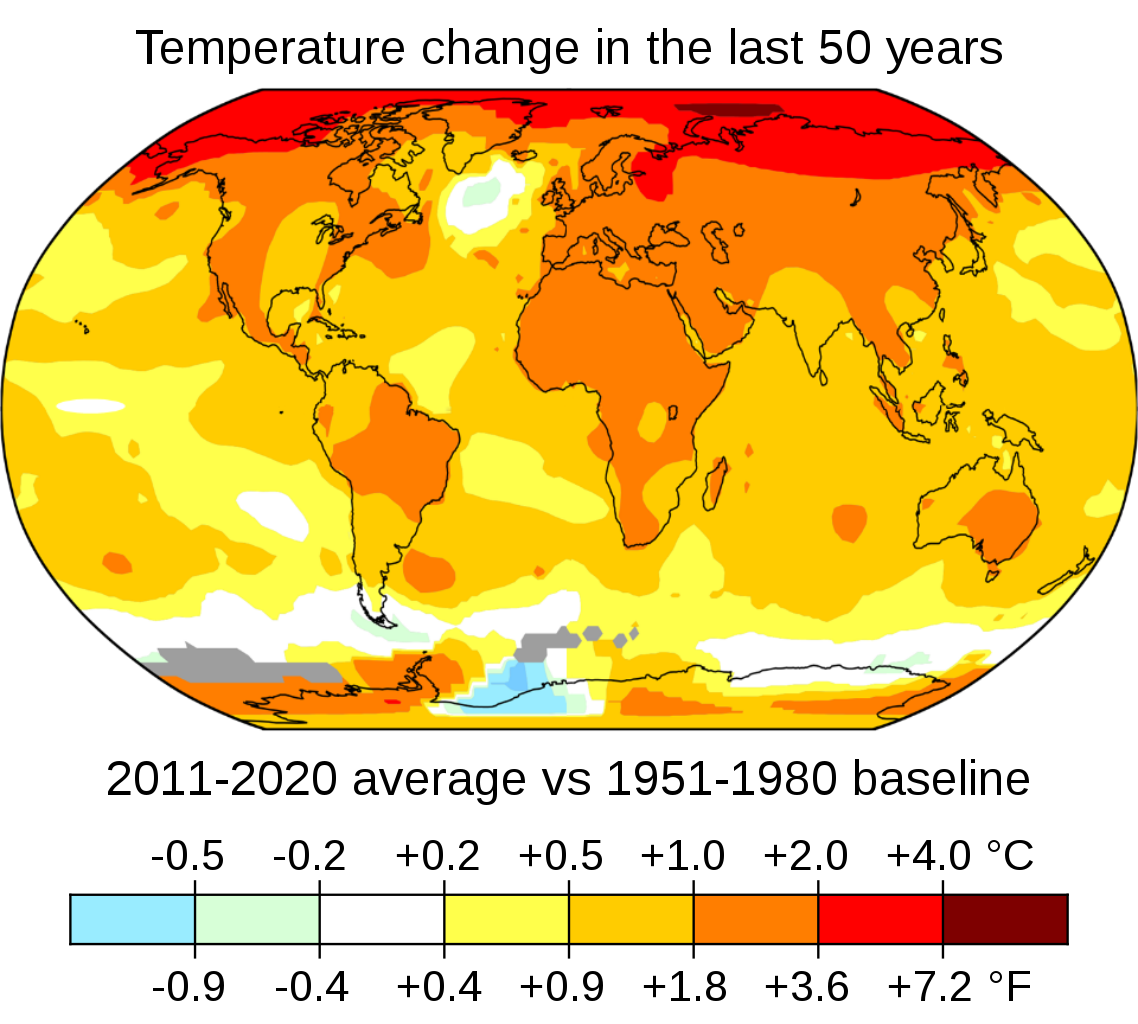
Figure \(\PageIndex{3}\): Temperature increases have been most pronounced in northern latitudes and over land masses. The colors represent the temperature difference between the 2011-2020 average and the 1951-1980 baseline, with warmer colors (yellow, orange, red) representing increases, and cool colors (green, blue) representing decreases. The image uses longer term averages of at least a decade to smooth out climate variability due to factors such as El Niño. Grey areas in the image have insufficient data for rendering. Image and caption (modified) from NASA’s Scientific Visualization Studio/Eric Fisk (public domain).
Temperature Changes
Climate models project the following key temperature-related changes:
- Average global temperatures are expected to increase by 1.1°C to 6.4°C by 2100, depending on the level of future greenhouse gas emissions, and the outcomes from various climate models.
- By 2100, global average temperature is expected to warm at least twice as much as it has during the last 100 years.
- Ground-level air temperatures are expected to continue to warm more rapidly over land than oceans.
- Some parts of the world are projected to see larger temperature increases than the global average.
These changes will impact our food supply, water resources, infrastructure, ecosystems, and even our own health. The magnitude and rate of future climate change will primarily depend on the following factors:
- The rate at which levels of greenhouse gas concentrations in our atmosphere continue to increase, often known as "climate scenarios" (Figure \(\PageIndex{4}\));
- How strongly features of the climate (e.g., temperature, precipitation, and sea level) respond to the expected increase in greenhouse gas concentrations; and
- Natural influences on climate (e.g., from volcanic activity and changes in the sun’s intensity) and natural processes within the climate system (e.g., changes in ocean circulation patterns).

Species that are highly mobile are not entirely spared from the negative impacts of climate change. Consider that migratory species rely on environmental cues, such as day length and temperature, to determine when to start moving from one area to the next. But because different species rely on different environmental cues to time their life cycles (e.g. breeding), not all species will adjust to climate change at the same rate. There is consequently a high likelihood that climate change will disrupt these synchronous movements that the animals in particular have developed over thousands to millions of years. This disruption of timed aspects of a species’ life cycle, such as migration and breeding, is called phenological mismatch. Researchers have already seen signs of phenological mismatch: some migratory birds that overwinter in the tropics have started to migrate to their breeding grounds at earlier dates than before. If these trends hold, they may soon start breeding before peak food availability, which could lead to lower fitness of offspring.
Resident species are also vulnerable to phenological mismatch. While these species might not be known for large-scale movements around the globe, they may still have to adjust their ranges to keep track of their climatic niches. Considering the improbability that different species will all adapt at the same pace, there is thus a danger that important mutualistic relationships might be pulled apart during these range adaptations. This is of concern for species with specialized feeding niches, as seen in some pollinators. Extinctions arising from this decoupling of mutualistic relationships are referred to as coextinction.
Freshwater ecosystems will generally experience temperature increases under climate change. Like their terrestrial counterparts, many freshwater species are sensitive to temperature shifts as warmer water also holds less dissolved oxygen. In addition, longer growing seasons and higher water temperatures will lead to increased nutrient loads, algae blooms, and eutrophication. All these factors will force many freshwater species—even those not sensitive to temperature shifts—to adjust their ranges to keep track of suitable conditions. For some freshwater species, the impediments to adjusting their ranges as necessary may be insurmountable.
Not all species will be impacted negatively. A variety of species are expected to benefit from climate change. These include generalist species currently limited by interactions with localized specialists that are—at least at present—better competitors for limiting resources. Some tropical species may thrive as their habitats become hotter and wetter. Species with high genetic diversity that reproduce quickly (allowing for rapid adaption to environmental changes) are also likely to benefit. Unfortunately, many species that exhibit these traits carry diseases and/or are agricultural pests. For example, populations of the coffee berry borer (Hypothenemus hampei)—Africa’s most notorious coffee pest—are expected to greatly increase in a warmer world. This growing threat is particularly worrying given that higher temperatures have already reduced coffee harvests in countries such as Tanzania by as much as 50%.
The range of disease-carrying insects and the viruses and pathogenic parasites they harbor will increase. This spread has already been documented in North America with several different diseases including West Nile and Lyme disease. Colder temperatures typically limit the distribution of certain species, such as the mosquitoes that transmit malaria, because freezing temperatures destroy their eggs. Not only will the range of some disease-causing insects expand, but increasing temperatures will also accelerate the host lifecycles, allowing them to breed and multiply more quickly. They may even evolve pesticide resistance faster. In addition to those listed above, other diseases such as dengue fever, malaria, yellow fever, zika virus, and chikungunya are expected to spread to new regions as the global climate warms.
Climate change does not only increase the spread of diseases in humans. Rising temperatures are associated with greater amphibian mortality due to chytridiomycosis (see Unit 5.2.3). Similarly, warmer temperatures have exacerbated bark beetle infestations of coniferous trees, such as pine and spruce.
How do climate factors (temperature, precipitation, & humidity) relate to vector-borne disease?
- Heavy rain increases the risk of animals transmitting pathogens.
- Milder winters increase the vector density & risk of disease
- Dry summers & drought increase the risk of vectors expanding their range
- More intense snowstorms Snow increase vector density & risk of disease
- Answer
-
B. Milder winters increase the vector density & risk of disease.
Precipitation and Storm Events
Patterns of precipitation and storm events, including both rain and snowfall are likely to change. However, some of these changes are less certain than the changes associated with temperature. Because warm air is able to hold more water than cold air, the general global trend over the past century has been one of increasing precipitation (Figure \(\PageIndex{5}\)).
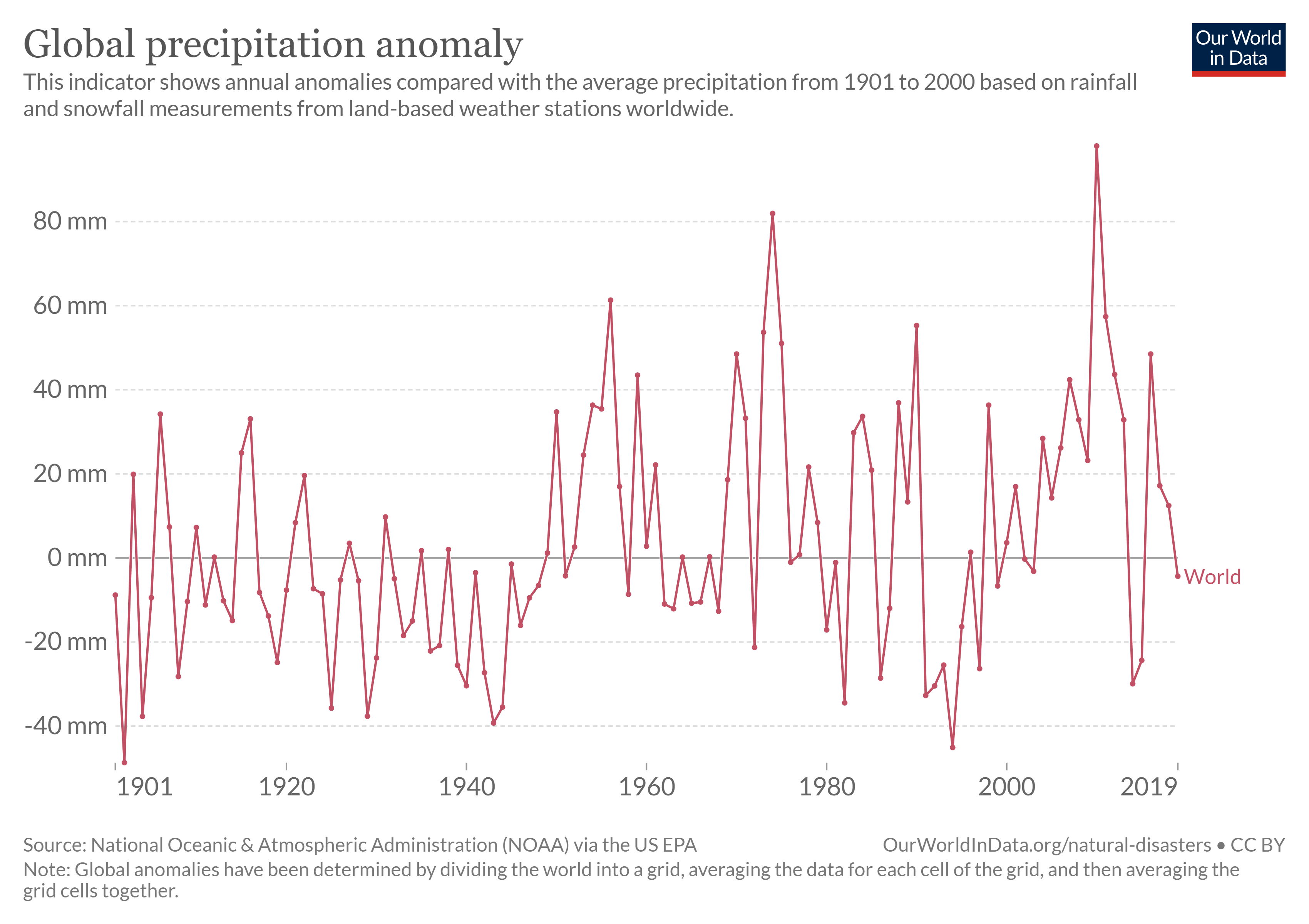
Figure \(\PageIndex{5}\): Data shows global precipitation patterns, based on rainfall and snowfall measurements from land-based weather stations worldwide. This indicator shows annual anomalies, or differences, compared with the average precipitation from 1901 to 2000. CC-BY United States Environmental Protection Agency (EPA)
Projections show that future precipitation and storm changes will vary by season and region. Some regions may have less precipitation, some may have more precipitation, and some may have little or no change. The amount of rain falling in heavy precipitation events is likely to increase in most regions, while storm tracks are projected to shift toward the poles. Climate models project the following precipitation and storm changes:
- Global average annual precipitation through the end of the century is expected to increase, although changes in the amount and intensity of precipitation will vary by region.
- The intensity of precipitation events will likely increase on average. This will be particularly pronounced in tropical and high-latitude regions, which are also expected to experience overall increases in precipitation.
- The strength of the winds associated with tropical storms is likely to increase. The amount of precipitation falling in tropical storms is also likely to increase.
- Annual average precipitation is projected to increase in some areas and decrease in others.
One of the other risks for coastal populations, besides sea-level rise, is that climate warming is also associated with an increase in the intensity of coastal storms (e.g., atmospheric rivers, hurricanes, cyclones, or typhoons), which almost always bring serious flooding from intense rain and storm surges. Some recent examples are the Vancouver floods of 2021 and the impact of Hurricane Fiona on Nova Scotia in 2022 (Figure \(\PageIndex{6}\)).

Changing precipitation levels will have several impacts on freshwater ecosystems, particularly as it relates to changes in their flow regimes. For example, areas that are undergoing decreased precipitation will experience decreased runoff and increased drying of wetlands and small streams, while areas with increased precipitation will experience increased storm surges and flushing. Given these multiple stressors, there is a reasonable expectation that many freshwater species will go extinct or face significant population declines and range shifts over the next decades. These changes are of major concern in countries that are currently majority subsistence, where so many people depend on fish and related natural resources for their livelihoods. Many communities around the world are already finding it more difficult to meet their nutritional needs due to climate-induced freshwater fish declines. Also, at some large lakes, which may supply 20–40% of the surrounding countries’ dietary protein—fish yields have decreased by 30% in recent years, also attributed to climate change.
Ice Melt and Sea Level Rise
Arctic sea ice is already declining. Sea ice is ice floating in the ocean (not on land like a glacier). Most sea ice is in the Arctic Ocean and the extent of sea ice is shrinking. Below, the NOAA animation shows how perennial sea ice has declined from 1990 to 2015. The oldest ice is white and the youngest (seasonal) ice is dark blue. The amount of old ice has declined from 20% in 1985 to 3% in 2015. For every 1°C of warming, models project about a 15% decrease in the extent of annually averaged sea ice (the total ice extent and concentration averaged over a year) and a 25% decrease in September Arctic sea ice.
This 2-minute video from the US's National Oceanic and Atmospheric Association illustrates the loss of Arctic sea ice from 1990-2015.
Question after watching: What seasonal patterns do you notice? What do you notice regarding the oldest ice over the 25 years portrayed in the video?
The land-based, coastal sections of the Greenland and Antarctic ice sheets have been melting significantly and are expected to continue to do so (Figure \(\PageIndex{7}\)). If the rate of this ice melting increases in the 21st century, these ice sheets could add significantly to global sea level rise and disrupt global ocean currents. Before anthropogenic warming, glacial activity was variable with some retreating and some advancing. Now, nearly all glaciers globally a retreating and expected to continue to melt, leading to freshwater shortages globally.

On average, the sea is rising at a rate of 1.8 mm per year. However, between 1993 and 2010 the rate of sea level increase ranged between 2.9 and 3.4 mm per year (Figure \(\PageIndex{8}\)). This is thought largely to be from both the melting of glaciers and thermal expansion. Thermal expansion means that as objects such as solids, liquids, and gases heat up, they expand in volume. Since 1970, the melting of glaciers and thermal expansion account for 75% of the sea-level rise (scientists are still researching the other 25%). As the oceans creep further inland, the extent of low-lying coastal ecosystems such as rocky shores or sandy beaches will shrink, and so also the sizes of the wildlife populations living in those areas.

Projections for sea level rise to the end of this century vary widely. This is in large part because we do not know which of the above climate change scenarios (Figure \(\PageIndex{3}\)) we will most closely follow, but many are in the range from 0.5 m to 2.0 m. One of the problems in predicting sea level rise is that we do not have a strong understanding of how large ice sheets, such as Greenland and Antarctica, will respond to future warming. Another issue is that the oceans do not respond immediately to warming. For example, with the current amount of warming, we are already committed to a future sea level rise of between 1.3 m and 1.9 m, even if we could stop climate change today.
What are the major causes of sea level rise?
- Melting sea ice
- Melting glaciers and ice sheets
- Seawater expanding as it gets warmer
- A and B
- B and C
- Answer
-
B and C. Melting glaciers and ice sheets and seawater expanding as it gets warmer.
Ocean Acidification and Deoxygenation
Since 1750, the ocean has absorbed about 30% of all anthropogenic carbon dioxide sources. When carbon dioxide gets absorbed in the ocean, it creates carbonic acid which makes the ocean more acidic. Ocean acidification is the process of ocean waters' decreasing pH (lower values are more acidic on the pH scale). The pH level of the oceans has decreased by approximately 0.1 pH units since pre-industrial times, which is equivalent to a 25% increase in acidity. The pH level of the oceans is projected to decrease even more by the end of the century as CO2 concentrations are expected to increase for the foreseeable future.
Ocean acidification adversely affects many marine species, including plankton, mollusks, shellfish, and corals. As ocean acidification increases, the availability of calcium carbonate will decline. Calcium carbonate is a key building block for the shells and skeletons of many marine organisms. Most tropical oceans have experienced extensive coral bleaching events in recent years due to increased sea surface temperatures and ocean acidification. Ocean acidification also disturbs predator-prey dynamics by impairing the senses of prey species and compromising the ability of marine creatures to communicate with those within their same species.
Marine fish and invertebrates rely on dissolved oxygen that enters the water either through the atmosphere or by photosynthetic plankton. But because warmer water absorbs less oxygen, scientists predict that some areas of the ocean will see a 3–6% drop in dissolved oxygen concentrations under climate change. This process, known as ocean deoxygenation, will leave parts of the ocean unsuitable for marine fishes and invertebrates, leading to dead zones. The impact of ocean deoxygenation will also be felt by economically important fisheries where climate change is predicted to lead to fisheries-related economic losses upwards of $415 million each year.
Acidification combined with warmer temperatures and lower oxygen levels is expected to have severe impacts on marine ecosystems, especially coral reefs, and associated fisheries possibly affecting our ocean-derived food sources.
What causes ocean acidification?
- Deoxygenated ocean water.
- Ocean pollution.
- Warm freshwater from land.
- CO2 dissolved in ocean water.
- Answer
-
D. CO2 dissolved in ocean water.
Climate Change Affects Everyone
We have all experienced the effects of climate change over the past decade. However, it is not straightforward for climatologists to make the connection between a warming climate and specific weather events, and most are justifiably reluctant to ascribe any specific event to climate change. In this respect, the best measures of climate change are those that we can detect over several decades, such as the temperature changes shown in Figure \(\PageIndex{2}\), or the sea level rise shown in Figure \(\PageIndex{7}\).
Our lives are connected to the climate. Human societies have adapted to the relatively stable climate we have enjoyed since the last ice age which ended several thousand years ago. A warming climate will bring changes that can affect our water supplies, agriculture, power and transportation systems, the natural environment, and even our own health and safety. Carbon dioxide can stay in the atmosphere for nearly a century, on average, so Earth will continue to warm in the coming decades. The warmer it gets, the greater the risk for more severe changes to the climate and Earth’s system. Although it is difficult to predict the exact impacts of climate change, what is clear is that the climate we are accustomed to is no longer a reliable guide for what to expect in the future.
In 2019, the Tsleil-Waututh Nation published a report entitled, "Understanding Our Community’s Climate Change Vulnerabilities: Community Climate Change Resilience Planning | PHASE 1 Summary". As noted in the report, "Climate change has the potential to profoundly impact the Tsleil-Waututh Nation (TWN) and many key aspects of community life. It influences the ability of our community to harvest some wild foods and medicinal plants, how we access the shoreline and marine waters, and how we connect with Nature. It poses community health risks, influence our ability to practice spiritual and cultural ceremonies, and share cultural teachings...This report serves to build an understanding of community vulnerability to climate change and begins to explore potential climate adaptation actions" (Tsleil-Waututh Nation, 2019).
The project focused on "climate change impacts to Tsleil-Waututh, also known as Burrard Inlet IR#3, which is the current village site for the Nation. In the future, TWN hopes to expand the assessment to consider the vulnerability of other areas within its traditional territory" (Tsleil-Waututh Nation, 2019).
Below is a summary of some of what this report details as possible impacts of climate change on the Tsleil-Waututh Nation:
- Coastal flood hazard modeling results showed that most waterfront properties may experience flooding during an extreme flood under a 2 m sea level rise scenario.
- Coastal erosion may affect waterfront properties and natural habitats, and threaten buildings, archeological, and other cultural sites.
- Ocean acidification from climate change poses an acute threat to species (particularly shellfish) along the mudflats and beaches of Burrard Inlet IR#3.
- [Loss of intertidal areas] will have significant impacts on species that live in the intertidal zone (e.g., shellfish) or that forage for food in these areas (e.g., marine birds and salmon). Many of these species are critically important as sources of food for TWN community and cultural health and serve as important opportunities to share traditional teachings (Figure \(\PageIndex{9}\)).
- The waters of Burrard Inlet will be increasingly vulnerable to harmful algal blooms as water temperatures rise and summer precipitation decreases.
- Climate change has the potential to make local waters more habitable for invasive non-native species, particularly those from warmer waters.
- Extended periods of extreme heat can cause heat exhaustion or heat stroke, particularly among vulnerable groups.
- Community member health and the opportunity for recreation, cultural practices, and job productivity is also impacted by poor air quality and smoke from wildfires across BC.
- Ongoing changes to air temperatures and precipitation patterns from climate change could increase the success and abundance of some invasive species.

Reference:
Tsleil-Waututh Nation. 2019. "Understanding Our Community’s Climate Change Vulnerabilities: Community Climate Change Resilience Planning | PHASE 1 Summary" British Columbia, Canada. Available from: https://twnation.ca/wp-content/uploa...e-Jan-2020.pdf
Learn how climate change will transform British Columbia by 2050 in this 3.5-minute video by CBC's Johanna Wagstaffe.
Question after watching: Which of the changes will affect you directly? Which of the changes will affect you indirectly?
Suggested Supplementary Reading
Intergovernmental Panel on Climate Change. 2021. 6th Assessment: Summary for Policymakers.
NASA. 2022. Global Climate Change: Vital Signs of the Planet. This website by NASA provides a multi-media smorgasbord of engaging content. Learn about climate change using data collected by NASA satellites and more.


